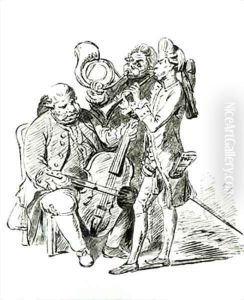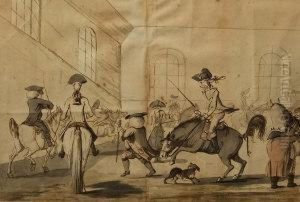James Bretherton Paintings
James Bretherton, an English printmaker and publisher, emerges in historical records primarily during the mid to late 18th century, with his death recorded in 1781. The exact year of his birth remains unknown, reflecting the often scant documentation for many artists and craftsmen of the period. Bretherton's career is most notably tied to the world of caricature and printmaking in England, a field that was burgeoning during his lifetime due to advances in printing technology and a growing public appetite for political and social satire.
Bretherton's professional life and contributions to art are closely associated with the vibrant print culture of London, particularly the area around Fleet Street, which was the center of the British book and print trade during the 18th century. He worked both as a publisher and a printmaker, a common practice at the time that allowed for greater control over the production and distribution of one's work. His shop became a hub for the sale of prints, maps, and books, contributing to the diffusion of visual culture in England.
Although not as widely recognized today as some of his contemporaries, such as William Hogarth or James Gillray, Bretherton played a significant role in the development of British caricature. He collaborated with various artists, including the renowned caricaturist Henry William Bunbury, publishing a number of Bunbury's works that satirized the manners and mores of Georgian England. These collaborations were instrumental in the evolution of caricature from a form of personal ridicule into a broader commentary on society and politics.
Bretherton's business acumen and his eye for marketable prints helped to popularize caricature and visual satire, making it accessible to a wider audience. His contributions to the art world, particularly in the realm of printmaking and publishing, reflect the dynamic interplay between art, commerce, and society in 18th-century England. Despite the lack of detailed personal information, James Bretherton's legacy endures through the prints he produced and published, which continue to offer insights into the cultural and political life of his time.

